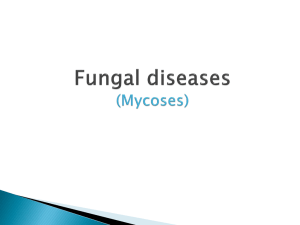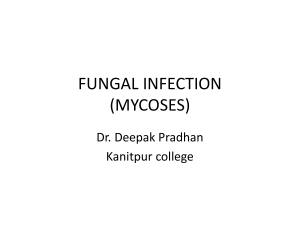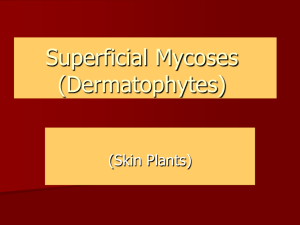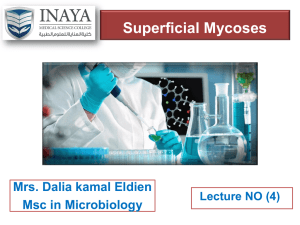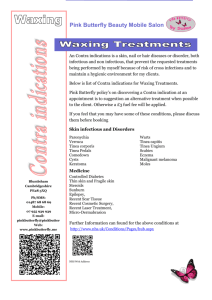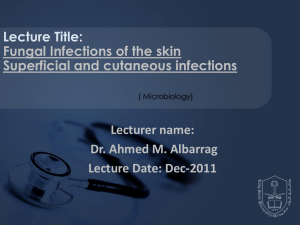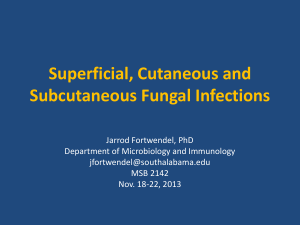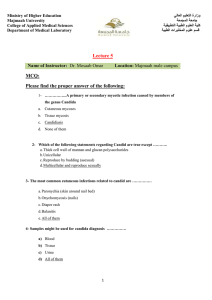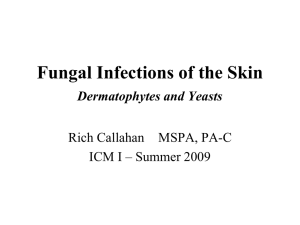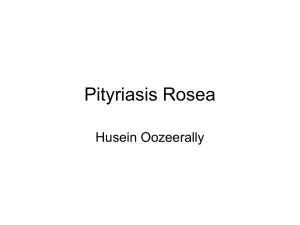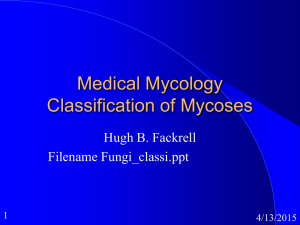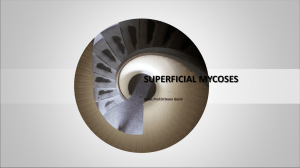Superficial & Cutaneous Mycoses: Presentation
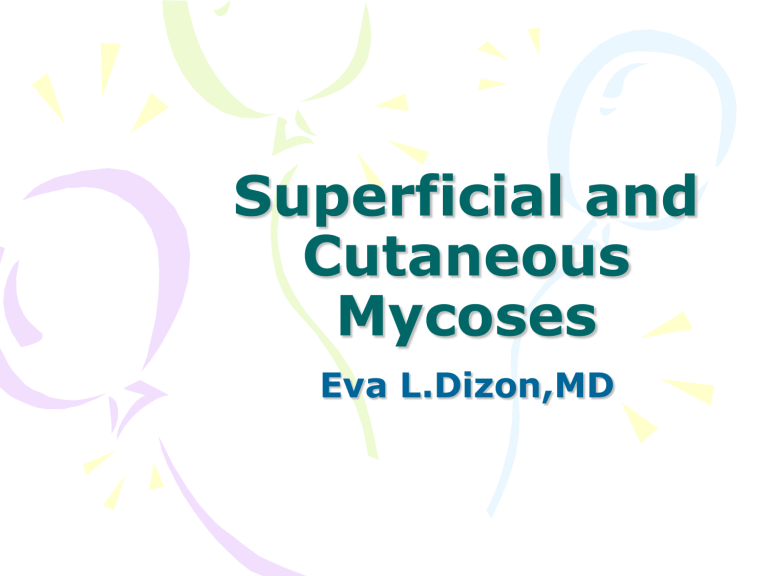
Superficial and
Cutaneous
Mycoses
Eva L.Dizon,MD
Superficial Mycoses
• Limited to the outermost layer of the skin
• 4 Infections
– 1.Pityriasis versicolor
– 2.Tinea nigra
– 3. Black piedra
– 4. White piedra
Superficial
• Do not elicit immune response
• No discomfort
• Cosmetic problems
• Limited to stratum corneum
Pityriasis Versicolor
• Malassezia furfur (Pityrosporum orbiculare)
• Lipophilic yeast like organism
• Rich in sebaceous glands
• Media is supplemented with fatty acids
• Exist in budding yeast,occasionally hyphal
Pityrisis versicolor (An-an)
Pityriasis
• Lesions are found in torso, arms and abdomen
• Scale very easily chalky appearance
• Rarely, papular or grow like folliculitis
Pityriasis
• Clinical Diagnosis:
KOH- Spaghetti and meatballs
• Treatment:
Azoles
Tinea Nigra
• Exophiala werneckii
• Produce melanin black or brown color
• Grows as yeast Older hyphae with mycelia and conidia
Tinea nigra
• Lesiongray to black macular palms
• Diagnosis-
Skin scrapings with alkali stain
• Cultures-
Sabourauds’s media pigmented yeast and hyphae
Black Piedra
• Piedraia hortae- exist in teleomorphic state
• Cultures – asexual state
- older cultures teleomorphic (asci ,which contain spindle shaped ascospores)
Black piedra
• Clinical feature: presence of hard nodules found along the infected hair shaft
• Nodules contain asci
White Piedra
• Trichosporon beigelii
• Grows in media without cyclohexamide
• Cultures are pasty and white developed deep radiating furrows and become yellow and creamy
White Piedra
• Microscopic examination septate hypae that develops into arthroconidia
• Hair- soft ,pasty,cream colored growth
Treatment
• Skin removal of the organism by:
1.Selenium sulfide
2.Thiosulfate
3.Salicylic acid
4.Hyposulfite inhibition of ergosterol by:
1.miconazole
Cutaneous mycoses
• Skin
• Hair
• Nails
• Evoke cellular immune response
• Dermatophytes
• Clinical manifestations ringworm or tinea
Cutaneous mycoses
• Etiology
Microsporum
Trichophyton
Epidermophyton
Cutaneous mycoses
• Classifications:
Anatomic location
Tinea pedis Tinea capitis
Tinea corporis
Tinea cruris
Ecologic location
Geophilic
Zoophilic
Anthrophilic
Cutaneous mycoses
• Keratophilic – use keratin as subject to live ( parasites)
• Keratinases- invade only keratinized layers
• 2 basic types of dermatophytic infection:
1. The acute or inflammatory type of infection, which is associated with CMI to the fungus, generally heals spontaneously or responds nicely to treatment.
2. The chronic or non-inflammatory types of infection, which is associated with a failure to express CMI to the fungus at the site of infection, is relapsing and responds poorly to treatment.
Cutaneous mycoses
Tinea corporis
Cutaneous mycoses
• THE IDENTIFICATION REACTION(ID)
• Patients infected with a dermatophyte may show a lesion, often on the hands, from which no fungi can be recovered or demonstrated.
• It is believed that these lesions, which often occur on the dominant hand (i.e. right-handed or left-handed), are secondary to immunological sensitization to a primary (and often unnoticed) infection located somewhere else (e.g. feet).
• These secondary lesions will not respond to topical treatment but will resolve if the primary infection is successfully treated.
Cutaneous mycoses
• Laboratory diagnosis: scrapings from clinical specimens
• Hair – endothrix (spores inside the hair shaft)
-ectothrix
- exception: T.schoenleinii
Disease-favus-waxy mass of hyphal elements (scutulum) microscopic –degenerated hyphal elements
Cutaneous mycoses
• Cultures
• Selective media – containing cycloheximide and chlorampenicol incubate at 25 C.
• Identification based on the conidia
Ringworm culture
Microsporum
General characteristics of Macroconidia and
Microconidia of Dermatophytes
Genus Macroconidia Microconidia
Microsporum Numerous, thick walled,rough
Rare
Epidermophyton Numerous, smooth walled
Absent
Trichophyton Rare,thin walled, smooth
Abundant
Microsporum
Trichophyton
Microsporum
Epidermophyton floccusom
Diagnosis
• Diagnosis is based upon:
1. Anatomical site infected
2. Type of lesion
3. Examination with a Woods lamp (366
A°)
4. Examination of KOH-treated skin scales from the infected area
5. Culture of the organism (not too important)
Differential diagnosis
• In a differential diagnosis you must consider:
1.
Leprosy
2.
Secondary syphilis
3.
Pityriasis rosea
4.
Psoriasis
5.
Nummular eczema
6.
Lichen planus
7.
Alopecia areata
8.
Trichotillomania
9.
Dyshidrosis
10.
Contact dermatitis.
Treatment
• Skin – azoles,inhibits cytochrome
450 dependent enzyme systems at the demethylation step from lanosterol to ergosterol
• Hair- Griseofulvin, oral , affects microtubular system
